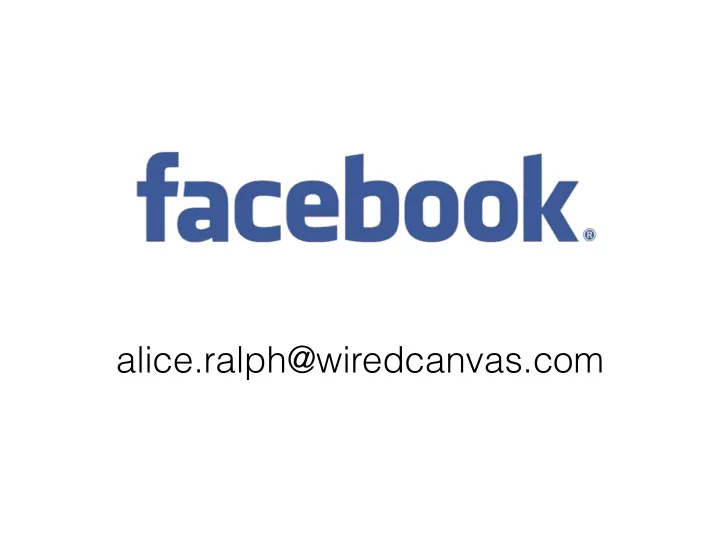

alice.ralph@wiredcanvas.com
Why use Facebook for your Read Easy group? • Spread the word: digital noticeboard • Recruit potential volunteers • Keep existing volunteers engaged • Raise awareness of Read Easy & adult literacy • Encourage donations
If you get stuck, go to: www.facebook.com/help
What is the difference between Profiles and Pages?
Profiles are for YOU (personal) Pages are for your BRAND (eg. Group) Profile Page
What can you post on a Profile and a Page? Profile Page • Update (Visible to ‘Friends’) • Update (Visible to Public & • Albums (Visible to ‘Friends’) Followers) • Albums (Visible to Public & • Event (Custom Privacy) Followers) • Messages Inbox (Private) • Event (Visible to invited • Groups (Private or Public) people) • Messages Inbox (Private)
What can the public do on your Group Facebook Page? ‘Like’ Page Private View Photos Message Public Post on Page Like Post Comment on Post
How to create a Page 2. Choose type of page 1. Go to: (Company, Organisation or www.facebook.com/pages/create Institution) 3. Choose ‘Community Organisation’ and give a name e.g. Read Easy Bournemouth
How to create a Page 4. Fill out the boxes… (About) Short description (max 155 characters) Website http://www.readeasy.org.uk Memorable URL /ReadEasyBournemouth
How to create a Page 4. Fill out the boxes… (Profile Picture) Upload from computer Select the logo JPG (available in Resources on website)
How to create a Page 4. Fill out the boxes… (Add to Favourites) Adds your new page to ‘Favourites’ on your Facebook sidebar menu so you can easily access it in future (Optional but recommended)
How to create a Page 4. Fill out the boxes… (Preferred Page Audience) Targeted is better! Choose your town/area (can choose multiple) Age: retired? Gender: all Interests: Reading, Volunteering, Charity and causes, Education etc (add multiple)
How to create a Page 5. Follow the guide!
What to add • Create a ‘Call to Action’ • Cover Photo • Profile Picture • Contact Details for Group • Invite friends and volunteers to like page! • Post an update!
Good Cover Photos • Famous landmark in area • Read Easy signage/stand • Group photo (Volunteers) • Tell a story
Adding an Update Text Status Photo/Video Offer, Event etc Boost Post (Paid Ad) Add an image Add a location Schedule Backdate Add an emoticon Save Draft
What to post? • Success stories • Testimonials / quotes from volunteers & readers • Photos and images (with permission) • Group news - eg. events, meetings etc • Share resources and ideas, book recommendations etc • News stories, press coverage, petitions etc • Ask your followers questions and for their input
What makes a good update? Clear, eye-catching image Short, punchy text - easy to read when scrolling through newsfeed “As lots of you remember ” - involves the reader Tells an emotive story Explains what charity is about Clear call to action (link to ‘read more’ on website)
What makes a good update? Name-drops the charity Casual, friendly tone of voice Personal - shows faces of the people behind the charity Thanking the audience - makes them feel appreciated and included
Telling a story doesn’t have to be complex www.facebook.com/humansofnewyork
Read Easy UK’s most popular update Includes a quote / testimonial Tells a great success story Includes a photo How to improve? • A picture that tells a story • Tag @BBC Radio Oxford • A link to the website / “Read more”
What makes a good update (just to recap!) • Always include a photo or image (if possible). • Think: “What would I like to see in my Facebook newsfeed?” • Share relevant content of interest to audience • Keep text short(ish) and easy to read - include link to full story on website if it requires more text. • Include clear calls to action, for example: “Click here to volunteer - [link]” “Sign the petition today - [link]” “Like and share this post if you agree!”
What NOT to post • Personal details/photos (without permission) • Updates with no context or assumed knowledge • Long text with no images or interest • Too informal/chatty… • …or too serious/business-like!
Tips • Put an @ before name to tag a person or a page eg. @Alice Ralph or @Read Easy UK • Schedule posts in advance • Don’t panic/overthink! Things can be edited afterwards! • Like and Reply to questions or comments on Page
Facebook Admins The benefits of having multiple Facebook admins: • Share the workload • If you go AWOL (eg. taken ill) then somebody else can easily take over managing the page • If your Facebook account was hacked then another account can revoke your access
How to add an admin 1. Go to your Page 2. Click on Settings (top right) 3. Click on Page Roles 4. Add admins by typing name (if they’re a Friend) or their email address 5. Select admin role
Admin Page Roles
Message Inbox
Insights
Add Facebook to your Group Page on website
Add Facebook to your Group Page on website 1. Go to www.readeasy.org.uk/ group-update 2. Log in with password Blockley2003 3. Fill out form including your Facebook URL (including http://) 4. An admin will add it to website
How to find these instructions again? 1. Go to www.readeasy.org.uk/ resources 2. Log in with your username/ email and password 3. Go to Group Resources 4. Go to Web & Social Media Resources
Thank you! alice.ralph@wiredcanvas.com
Recommend
More recommend